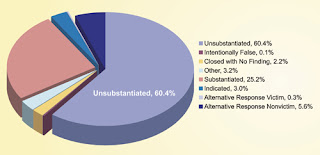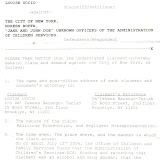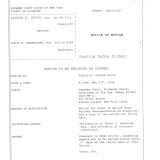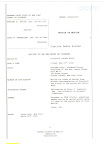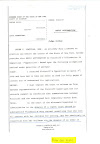 Please pass the word! This absolutely applies to every state and not just Florida.
Please pass the word! This absolutely applies to every state and not just Florida.You can see how the St. Petersburg Times promoted the story by clicking on all the links here: http://www.psychsearch.net/antipsychotics.htm
You'll also be able to see all the photos and graphics from the actual newspaper which was front page and also had two full pages inside.
Please focus on the facts in the below article and write a Letter to the Editor: http://www.sptimes.com/letters/
Please focus on the facts in the below article and write a Letter to the Editor: http://www.sptimes.com/letters/
Medicaid = State and Federally funded insurance for the poor and disabled.
Right - your tax dollars.
Atypical Antipyschotics = The "new" antipsychotics that pharmaceuticals are pushing. High powered mind altering drugs, chemical straight jackets, that have been shown to cause huge weight gain, diabetes and even death.
Atypical Antipyschotics = The "new" antipsychotics that pharmaceuticals are pushing. High powered mind altering drugs, chemical straight jackets, that have been shown to cause huge weight gain, diabetes and even death.
Antipsychotics are the most powerful psychiatric drugs in existence and can actually cause permament brain damage.
Some of the other side effects are:
(1) prolonged and frequently permanent muscle spasms and tics often involving the face, neck, shoulders and upper limbs
(2) inability to sit still with extreme uncontrolled restlessness
(3) excessive movement of the lips, tongue and jaw, Other abnormal movements include jerky, abrupt movements of the limbs and body
And these drugs are being given to children.
Quotes from the article:
"Last year, more than 18,000 state kids on Medicaid were given prescriptions for antipsychotic drugs. Even children as young as 3 years old. Last year, 1,100 Medicaid children under 6 were prescribed antipsychotics, a practice so risky that state regulators say it should be used only in extreme cases."
"There is almost no research on the long-term effects of such powerful medications on the developing brains of children."
"The bottom line is that the use of psychiatric medications far exceeds the evidence of safety and effectiveness...
And these drugs are being given to children.
Quotes from the article:
"Last year, more than 18,000 state kids on Medicaid were given prescriptions for antipsychotic drugs. Even children as young as 3 years old. Last year, 1,100 Medicaid children under 6 were prescribed antipsychotics, a practice so risky that state regulators say it should be used only in extreme cases."
"There is almost no research on the long-term effects of such powerful medications on the developing brains of children."
"The bottom line is that the use of psychiatric medications far exceeds the evidence of safety and effectiveness...
What people need to do is what's in the best interest of children instead of what's in the best interest of people's pocketbooks."
"It is not a scientific use of drugs," Whitaker said. "It is an experiment. There is no data showing that they are helpful in a 3-year-old kid. None. Zero. Zip. It mutes your ability to respond to the world, emotionally and physically,"
St. Petersburg Times
The 'atypical' dilemma
Skyrocketing numbers of kids are prescribed powerful antipsychotic drugs.
Is it safe? Nobody knows.
ROBERT FARLEY
Times Staff WriterJuly 29, 2007
More and more, parents at wit's end are begging doctors to help them calm their aggressive children or control their kids with ADHD. More and more, doctors are prescribing powerful antipsychotic drugs.
In the past seven years, the number of Florida children prescribed such drugs has increased some 250 percent. Last year, more than 18,000 state kids on Medicaid were given prescriptions for antipsychotic drugs.
Even children as young as 3 years old. Last year, 1,100 Medicaid children under 6 were prescribed antipsychotics, a practice so risky that state regulators say it should be used only in extreme cases.
These numbers are just for children on fee-for-service Medicaid, generally the poor and disabled. Thousands more kids on private insurance are also on antipsychotics.
Almost entirely driving this spiraling trend is the rise of a class of antipsychotic drugs called atypicals.
These drugs emerged in the 1990s and replaced the older, "typical" antipsychotics like Haldol or Thorazine, which are often associated with Parkinson-like shakes.
The atypicals were developed to treat schizophrenia and bipolar disorder in adults. But once on the market, doctors are free to prescribe them to children, and for uses not approved by the Food and Drug Administration.
There is almost no research on the long-term effects of such powerful medications on the developing brains of children. The more that researchers learn, the less comfortable many are becoming with atypicals.
Initially billed as wonder drugs with few significant side effects, evidence is mounting that they can cause rapid weight gain, diabetes, even death.
They're also expensive. On average last year, it cost Medicaid nearly $1,800 for each child on atypical antipsychotics. In the last seven years, the cost to taxpayers for atypical antipsychotics prescribed to children in Florida jumped nearly 500 percent, from $4.7-million to $27.5-million.
Medicaid and insurance companies have fed the problem, encouraging the use of psychiatric drugs as they reimburse less and less for labor-intensive psychotherapy and occupational therapy.
Another factor: Doctors have been influenced by pharmaceutical companies, which have aggressively marketed atypicals.
Whatever the reasons for the soaring use of psychiatric drugs in children, things have gotten out of whack, according to Dr. Ronald Brown. Last year he headed an American Psychological Association committee that looked into the issue.
"The bottom line is that the use of psychiatric medications far exceeds the evidence of safety and effectiveness," Brown said.
"What people need to do is what's in the best interest of children instead of what's in the best interest of people's pocketbooks. But children don't vote."
* * *
The ever-increasing number of kids who come through the doors of pediatrician Esther Gonzalez's office lead chaotic lives.
There's more divorce and more drug use, more domestic violence and physical and sexual abuse. Working parents are overwhelmed.
"Some parents are so stressed out, they come in seeking a pill," Gonzalez said. It is easy to medicate kids; "it is very hard to change environment."
At her practice in Crystal River, she starts with a thorough screening. A child might need occupational, physical or speech therapy. Sometimes, it takes psychiatric drugs.
Despite her concerns about prescribing such medications, Gonzalez has no doubt they have saved many a child from juvenile detention.
Not prescribing drugs to a child who needs them, she said, "it's like seeing someone dying and not giving them CPR."
Among her patients is 7-year-old Matthew Peck of Brooksville. His 13-year-old brother and 16-year-old sister show scars on their arms and legs where he has bitten them. He flies into rages, kicks, scratches and pulls hair. He destroys furniture and punches holes in the wall.
His mom, Cathy Peck, said Matthew's doctors are "leaning toward" a diagnosis of oppositional defiance disorder. And he has attention-deficit hyperactivity disorder (ADHD).
Matthew has taken a 5 mg dose of the atypical Abilify for over two months now. He says "the blue pill" makes him feel like a different person, someone nice.
Peck, a single mother on disability from the Army National Guard, says she worries the drugs may become addictive. And diabetes runs in the family, so that's a concern. Then again ... a few months ago Matthew got hold of a steak knife and destroyed a chair.
"Am I afraid of what the medications might do to him? Yes," Peck said. "But I am also afraid of what his life would be like without them."
Matthew and his brother are playing. Suddenly Matthew raises a hand to hit him.
"Gather!" Cathy Peck yells, the trigger word to help Matthew calm himself.
He lowers his hand, shambles over to his mother, curls up behind her. Crisis avoided.
Matthew's 13-year-old sister, Marradith, said the Abilify works. "He's a different person. He's more fun to be around. He doesn't attack me anymore."
Matthew's 13-year-old sister, Marradith, said the Abilify works. "He's a different person. He's more fun to be around. He doesn't attack me anymore."
The meds help, Mom says, but therapy is integral to Matthew's treatment. She was taking him to eight sessions a week of occupational, speech and language therapy.
Matthew recently had his last occupational therapy session - but not by choice. After six years, Sensations Pediatrics Therapy in Brooksville closed shop on June 15.
That last day of business, Sensations owner Jeff Leonbruno lamented how hard it is for therapists to stay afloat. Particularly with pediatric therapy sessions, he said, there is a high cancellation and no-show rate, often four or five a day. If they don't show, he can't charge.
"It's difficult to make a living at it," Leonbruno said.
Insurance companies and Medicaid don't pay enough for therapy, he said.
They do, however, pay to reimburse for psychiatric medications.
Over the years, he said, Medicaid priorities have shifted toward the elderly in nursing homes. That has put a pinch on services like occupational therapy for children with behavioral disorders.
"There's no AARP for kids," he said.
* * *
Before the FDA approves a new drug, pharmaceutical companies must demonstrate its safety and efficacy. The trials generally are done on adults.
But once the drugs are on the market, doctors are free to prescribe the drug "off label," outside the scope of the FDA's indicated use. They also can prescribe it to children.
Except for Risperdal, none of the antipsychotics is FDA-approved for children. The overwhelming majority are prescribed "off label."
"It is alarming how frequently that is being done," Brown said.
"It's of concern that it is being done at all."
A child's brain and central nervous system are still developing, so drugs work differently on kids than adults, Brown said. "There are no studies that have shown they (atypicals) are safe, or for that matter, that they are effective for children."
Drug companies have little incentive to invest in such studies, given that their products already are widely prescribed to children off label.
The antipsychotics are FDA-approved for adults with schizophrenia and bipolar disorder, which used to be known as manic depression. But a study by the University of South Florida found that just 8 percent of Florida children prescribed antipsychotics last year had a primary diagnosis of schizophrenia, and 8 percent had major depression.
The most common diagnosis, 38 percent, was ADHD.
Even with bipolar disorder, there is considerable debate in the mental health community about whether it is overdiagnosed, particularly in younger children.
Dr. Mark Olfson of Columbia University studied the use of antipsychotics in children and concluded that only a small percentage had psychotic disorders.
Most were used to treat mood disorders, depression, anxiety and ADHD - by families and doctors who have tried everything else and are ready to step outside the well-established treatments and take more risks.
"Most child psychiatrists would probably tell you it does work," Olfson said. "But there is a real need for research, clinical experiments, to determine whether in fact it does work.
Given the number of young people, it is a matter of urgency."
Mental health practitioners say they use more antipsychotics now in part because they are better able to identify some mental illnesses, including autism.
Never mind that the National Autism Association warns against the overuse of atypicals for children with autism. Last year, when Risperdal became the first and only atypical approved for use in children - specifically for irritability associated with autism - the association warned against potentially serious side effects, including lactation in boys, weight gain and development of an often irreversible movement disorder.
Rita Shreffler, the autism association's executive director, said antipsychotics should be used only for dangerously aggressive children, and even then only for a short "leveling off period."
Dr. Randall Stafford, an associate professor of medicine at Stanford Prevention Research Center, says off-label prescribing allows doctors the latitude to innovate.
But Stafford was the lead author of a study that concluded that most off-label medication occurs without enough scientific support.
Some prescriptions have become so common, he said, "You have to ask, 'Where is the data to support this use of the drug?' It's not that these off-label uses are dangerous. It's that we just don't know."
* * *
Kate Malloy knows what people will think:
Every kid throws tantrums; parents just need to discipline their children.
My footnotesin blue here-
Child (anything BUT) protective services
NEEDS TO ALLOW parents to parent-
NON Family Courts NEED TO ALLOW FULL ACCESS TO BOTH PARENTS!!! Pharma Co.'s
NEED TO BACK OFF-
Teachers NEED to learn to deal with children or work in a pet store!
This my friends will save the future generation!
But with 10-year-old Ryan, she said, the outbursts were beyond aggressive.
He seemed outside himself.
A psychologist diagnosed bipolar disorder and recommended they see a psychiatrist.
"You are under the impression that when you go to the doctor you'll be fixed," she said. "And that isn't how it works. They don't, by any means, have all the answers."
A psychologist diagnosed bipolar disorder and recommended they see a psychiatrist.
"You are under the impression that when you go to the doctor you'll be fixed," she said. "And that isn't how it works. They don't, by any means, have all the answers."
The ADHD medication Ryan was prescribed only inflamed things, and therapy fell flat. They tried atypicals, first Risperdal. Then Zyprexa. Then Seroquel.
"In the beginning, when the meds weren't working, I hated them," she said.
"I hated that they were the only option."
She took Ryan off all the medications and tried an alternative doctor, who recommended dietary supplements. That worked, but only for a while.
She went to Dr. Mark Cavitt, medical director of pediatric psychiatry at All Children's Hospital in St. Petersburg.
He says mental health practitioners operate in gray areas. The unknowns of the long-term effects of psychotropic drugs have to be balanced against the risk of not treating.
Studies show that atypicals can be effective in modifying aggressive behavior, he said, and that kids who are treated for depression and schizophrenia are less likely to fall prey to pitfalls like drug abuse and teen pregnancy.
Then again: "We have to be concerned.
There is no such thing as a benign psychiatric medication."
Dr. Cavitt prescribed Risperdal for Ryan. He couldn't tell when he was full and gained 15 pounds. When Risperdal stopped working, they switched to Abilify.
Mom hates to think about the possible long-term effects but has more immediate concerns, like, "Will he jump out of a moving car?"
"There are certainly downsides to medications," she said. "But when medications don't work, we are pretty much screwed. There are not a lot of options."
* * *
At the Suncoast Center for Community Health in Clearwater, the focus is on therapy. Drugs are a last resort.
Renee Kilroy, the clinical director, said the sharp increase in psychotropic medications to children is unsettling.
"It's not my belief we need to put more kids on medications.
They are still growing and changing."
Therapy costs more in the short term, she said, but a lifetime of medications is costlier. Suncoast can afford to take the longer view thanks to subsidies it gets from the county's Juvenile Welfare Board.
More and more, she said, they get referrals from the school system for disruptive kids. Parents tell her that the school has told them their children need to be put on psychiatric medication before they can come back - even though state law specifically forbids that.
* * *
Children younger than 6 generally should not be given psychotropic drugs. According to guidelines from the Florida Agency for Health Care Administration, it should "only be considered under the most extraordinary of circumstances."
Last year, 1,111 Florida Medicaid children younger than 6 were prescribed antipsychotics.
There is no recommendation for the use of antidepressants in children younger than 6 - yet 629 children were prescribed antidepressants last year.
Using stimulant medications for ADHD should be "rare" for kids younger than 4, the guidelines state, "and only after a failed behavioral intervention such as parent training." Last year, 367 toddlers 3 and younger were prescribed ADHD medications.
Cavitt said 3-year-olds put on psychotropic medications typically are autistic, mentally retarded or brain injured. They are extremely self-injurious or physically aggressive to others, he said.
Robert Whitaker, a journalist and author of the book Mad in America, says there is no circumstance where it makes sense to prescribe an antipsychotic drug to a 3-year-old.
"It is not a scientific use of drugs," Whitaker said. "It is an experiment. There is no data showing that they are helpful in a 3-year-old kid. None. Zero. Zip."
Rather, he said, it is using medication as a controlling device. Whitaker blames a system of "assembly line medicine," where psychiatrists are afforded less and less time with patients.
Atypicals provide a shortcut to dealing with unruly children.
"It mutes your ability to respond to the world, emotionally and physically," he said. "They make them easier to manage, to others."
"It mutes your ability to respond to the world, emotionally and physically," he said. "They make them easier to manage, to others."
The pharmaceutical companies also help to shape the prescribing patterns, he said. The law forbids them from openly marketing to children off-label, but as any child psychiatrist will tell you, pharmaceutical reps for the atypicals are regular visitors.
Psychiatrists like Cavitt say the reps know the line: They are there only to provide company research and to solicit feedback on the use of their medications.
But Whitaker said it's clear why the reps for atypicals are in the offices of child psychiatrists: "They do it because they know it's effective in promoting off-label uses of their drugs.
"They are publicly traded companies trying to maximize their revenues. It increases off-label use, and doctors should quit pretending otherwise."
Minnesota is the only state that requires public reports of all drug company marketing payments to doctors. A recent New York Times analysis of those records found that doctors who took the most money from makers of atypicals tended to prescribe the drugs to children the most.
* * *
The support group for people whose relatives have committed suicide was unveiling a quilt with squares in memory of each person.
Kathy Pingleton was seated in a plastic chair in the back row when her son's name was called.
"Brandon Lee Pingleton."
Her husband, Ken, put his arm around her and they made their way to the front.
Kathy stole a glance at the section of quilt she made in honor of Brandon, a 15-year-old sophomore at Largo High School.
She worried that she made the square too busy. Lots of pictures and buttons to show Brandon's love of football, soccer and karate.
Kathy reached out a hand to light a candle in his memory. On one finger was a ring made of a guitar string that Brandon used. It reminds her of his artistic side.
Nearly four years ago she and Ken found Brandon hanging in his bedroom, just feet from where they were.
Diagnosed with ADHD, Brandon had landed in a county crisis center after he overdosed on Robitussin and told authorities he was depressed.
When he was released from the center, mom remembers taking him to a psychiatrist. After 5 minutes of evaluation - "How are you sleeping? How is school?" - the doctor doubled his dosage of the atypical antipsychotic Seroquel.
She remembers wondering why he was taking the drug when the Web site said it was for schizophrenia and bipolar disorder.
She hated what the drugs did to him, as did Brandon. He said it made him feel like a zombie.
Seroquel now carries a black box warning that antidepressants may increase the risk of suicidal thoughts in children and teenagers, and that patients should be watched closely.
Those warnings didn't come until 2004. Brandon hanged himself in 2003.
* * *
Alan Levine ran the state's Agency for Health Care Administration in 2005. He became so alarmed by the spike in antipsychotics prescribed to children that he contracted with USF to study the trend.
The study found that from mid 2002 to mid 2004, the cost of psychotropic drug prescriptions for kids increased 60 percent. Pacing that increase was an 82 percent jump in spending on atypical antipsychotics.
"It has very quietly grown as a problem," Levine said.
He wanted to reel it in, but not in a knee-jerk way that might hurt kids who need medications. "There needs to be a more sane and evidence-based approach when prescribing these drugs to children."
The use of antidepressants and ADHD medications dropped and the growth of antipsychotics slowed over a two-year period, starting in April 2004.
By then, said Robert Constantine at USF's Louis De La Parte Mental Health Institute, any psychiatrist would have been aware of the metabolic side effects of the new antipsychotics, and, for those taking antidepressants, the dangers of suicidal feelings.
As part of the $3-million state grant, USF was charged with sending out letters to physicians who were regularly prescribing outside the accepted guidelines.
For example, in the first quarter of this year, 315 children on Medicaid got antipsychotics at higher-than-recommended dosage levels.
Another common problem, Constantine said, was the practice of prescribing more than one antipsychotic at a time.
Some doctors swear it works
but there isn't much scientific evidence to back that up.
The first three months this year
274 children were prescribed two or more antipsychotics for an extended period.
Joanne Mills' 12-year-old son was on 16 medications.
At the same time.
"At the time we decided to put him on each one of them there was a good reason for it, or else we wouldn't have done it," said Mills, a mother of six in Homosassa.
In the last year, by integrating therapy, she said they have cut her son's 16 medications to three, including the atypical Seroquel.
He has been diagnosed with ADHD and occasionally explosive behavior. For three years, she had to hold him for three hours a night so he could sleep.
Frustrated to the nth degree, she says you walk into the doctor's office with a bubble of hope, and walk out 15 minutes later with a handful of prescriptions, for drugs you've tried before without any lasting benefit.
"The doctors throw their hands up in the air and say, 'I don't know what else to try.' "
About the numbers
Most of the statistics in this story are derived from Medicaid data provided by Florida's Agency for Health Care Administration.
The agency provided the same data to the University of South Florida, which was contracted by the state to study prescribing patterns.
As a public service, USF prepared an analysis of the state's data for the St. Petersburg Times.
The numbers include only children on fee-for-service Medicaid.
They do not include children in Medicaid HMOs or those with private insurance.
Some 720,000 children were in the fee-for-service Medicaid program last year, out of some 4.5-million children in Florida.
That means the statistics in this story vastly underestimate the entire picture of antipsychotic medications prescribed to children.
The Medicaid numbers were used because the program is taxpayer
-funded and the information is public.
The atypicals
A new class of drugs emerged in the 1990s, touted as a better and safer way to treat schizophrenia and bipolar disorder.
Here are the atypicals now on the market.
Trade name Drug name Marketed by
Clozaril Clozapine Novartis
Zyprexa Olanzapine Eli Lilly and Co.
Risperdal Risperidone Janssen Pharmaceutica
Seroquel Quetiapine AstraZeneca
Geodon Ziprasidone Pfizer
Abilify Aripiprazole Otsuka Pharmaceutical Co.
Invega Paliperidone Janssen Pharmaceutica

